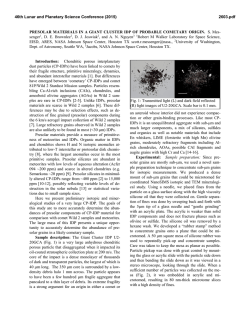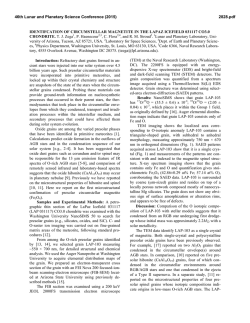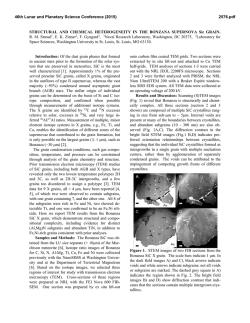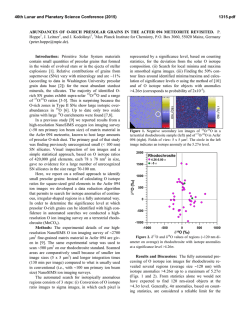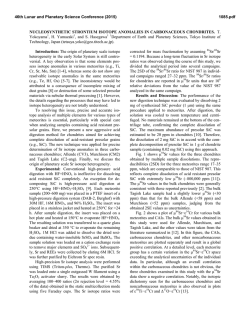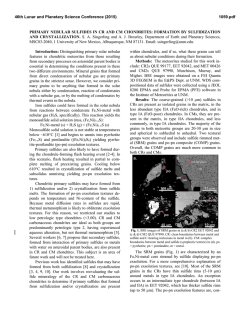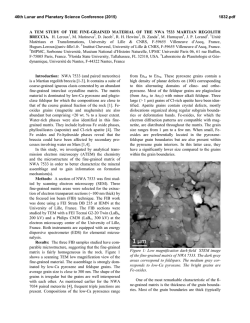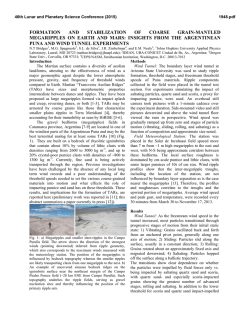
Simultaneous Analysis of Strontium, Zirconium, and Barium Isotopes
46th Lunar and Planetary Science Conference (2015) 2825.pdf SIMULTANEOUS ANALYSIS OF STRONTIUM, ZIRCONIUM, AND BARIUM ISOTOPES IN PRESOLAR SILICON CARBIDE GRAINS WITH CHILI. T. Stephan1,2,3, R. Trappitsch1,2, A. M. Davis1,2,4, M. J. Pellin1,2,3,4, D. Rost1,2,3, M. R. Savina2,3, and N. Dauphas1,2,4, 1Department of the Geophysical Sciences, The University of Chicago, Chicago, IL 60637, USA, 2Chicago Center for Cosmochemistry, 3Materials Science Division, Argonne National Laboratory, Argonne, IL 60439, USA, 4The Enrico Fermi Institute, The University of Chicago, Chicago, IL 60637, USA. ([email protected]) Introduction: After more than five years of designing and building the Chicago Instrument for Laser Ionization (CHILI) [1–6], we present the first analyses of natural materials. CHILI is a resonance ionization mass spectrometry (RIMS) instrument that is designed to surpass the capabilities of the previous generation RIMS instruments CHARISMA [7] and SARISA [8], with regard to useful yield (~40 %), lateral resolution (~10 nm), and number of photoionization lasers (six, allowing measurement of isotopic compositions of several elements at once). As an initial demonstration, we chose to analyze presolar SiC grains for the isotopic compositions of Sr, Zr, and Ba, three elements that are particularly important for understanding the s-process in asymptotic giant branch stars [9–12]. Samples: Presolar SiC grains from mount KJG#2 were analyzed in this study. The grains were extracted from the Murchison CM2 meteorite more than 20 years ago [13]. In contrast to recent work on KJG grains [9– 12], the samples in this study were not additionally treated with concentrated acids to remove parent-body or terrestrial contamination. The grains were mounted on a high purity gold foil by depositing them from a suspension and pressing them into the gold with a sapphire window. Prior to RIMS analysis, energy dispersive X-ray images of the mount were acquired in a scanning electron microscope to locate SiC grains on the gold foil. Twelve grains were selected for this study. RIMS analysis: CHILI is equipped with six tunable Ti:sapphire lasers, pumped by three 40 W, 527 nm Nd:YLF lasers. This allows simultaneous resonance ionization of three elements with independent twophoton ionization schemes or two elements with threephoton schemes. A three-prism beam combiner brings all six laser beams with different wavelengths onto a single line through the analysis chamber. Using a broadband mirror, the laser beams are reflected so that they travel twice through a cloud of neutrals, which were desorbed by a 351 nm Nd:YLF laser beam, focused to ~1 µm using a Schwarzschild optical microscope, and rastered over the sample. Using previously developed ionization schemes, the Ti:sapphire lasers were tuned for resonance ionization of Sr (λ1 = 460.862 nm, λ2 = 405.214 nm [11, 12]), Zr (λ1 = 296.172 nm, λ2 = 442.533 nm [14]), and Ba (λ1 = 307.247 nm, λ2 = 883.472 nm [15]). Isotopic standards used in this study are NIST SRM 855a with 180 ppm Sr, Zr metal, NIST SRM 1264a with 690 ppm Zr, and terrestrial BaTiO3, all of which were assumed to be of normal terrestrial isotopic composition. Data were corrected for dead time effects [16]; the detector dead time was found to be 600 ps, which was determined by analyzing a Zr metal standard by ion sputtering with varying primary ion beam current. Instrumental isotopic fractionation was determined to be smaller than the statistical error of typically a few tens of ‰ except for 91 Zr, which showed enhanced laser resonance ionization by ~210 ‰ due to an odd-even effect as had been previously observed [17] and which is corrected for by analyzing standards. Results and Discussion: Six of the twelve grains selected had sufficient Ba content for isotopic analysis with CHILI. Five of these six grains also showed sufficient Sr concentration. However, none of the grains had enough Zr to detect any Zr mass peaks. For KJH grains, which are larger in diameter by a factor of ~2 than our KJG grains, a previous study showed that about one third had enough Zr for isotope analysis with CHARISMA [17]. According to trace element analyses by secondary ion mass spectrometry and synchrotron Xray fluorescence, ~50 % of SiC grains are expected to be enriched in Zr/Si by more than a factor of 2 compared to CI meteorites [18, 19]. Although absolute element concentrations cannot be easily determined with CHILI, from the analysis of the NIST SRM 1264a with 690 ppm Zr, we infer that Zr isotope analysis should be possible for such enriched grains. Why no Zr was found in the present study needs further investigation. Sr and Ba isotopic ratios, normalized to 86Sr and 136 Ba, respectively, are displayed in Figs. 1 and 2 as δ values (deviation from standards in ‰). For comparison, Figs. 1 and 2 also show data obtained with CHARISMA on SiC grains that had undergone acid cleaning [9–12]. The SiC grains analyzed in the present study show a similar range of isotope ratios as in the previous studies. However, there seems to be a tendency to plot closer to normal than the previously analyzed grains; residual parent-body or terrestrial contamination could be responsible for such a trend. Conclusions and Outlook: CHILI has analyzed its first natural samples. With regard to sensitivity, lateral resolution, and mass resolution, we have not yet reached the performance aimed for. However, we are still learning how to tune the instrument. Some improvements to be implemented shortly will: (1) increase the sensitivity by letting the laser light pass eight times through the analysis chamber; (2) optimize motionless blanking of the ion gun to achieve high lateral resolution; (3) re- 46th Lunar and Planetary Science Conference (2015) +200 δ(138Ba/136Ba) [‰] 0 +200 0 -200 -400 -600 -800 +800 +200 +600 0 +400 -200 -400 δ(134Ba/136Ba) [‰] δ(88Sr/86Sr) [‰] -400 -800 +400 -600 +1200 +1000 +800 δ(87Sr/86Sr) [‰] -200 -600 δ(137Ba/136Ba) [‰] place and mechanically align the reflectron in the timeof-flight mass spectrometer for higher mass resolution and transmission. Even without these improvements, CHILI is more capable than earlier RIMS instruments. A wide variety of cosmochemical problems will be explored in the near future, including isotopic studies of presolar grains, CAIs, and samples from Genesis and Stardust. References: [1] Davis A. M. et al. (2009) LPS 40, #2472. [2] Stephan T. et al. (2010) LPS 41, #2321. [3] Stephan T. et al. (2011) LPS 42, #1995. [4] Stephan T. et al. (2012) LPS 43, #2660. [5] Stephan T. et al. (2013) LPS 44, #2536. [6] Stephan T. et al. (2014) LPS 45, #2242. [7] Ma Z. et al. (1995) Rev. Sci. Instrum., 66, 3168–3176. [8] Veryovkin I. V. et al. (2004) Nucl. Instr. and Meth. B, 219–220, 473–479. [9] Liu N. et al. (2014) ApJ, 786, 66-1–66-20. [10] Liu N. et al. (2014) ApJ, 788, 163-1–163-7. [11] Liu N. et al. (2015) ApJ, submitted. [12] Liu N. (2014) Dissertation, The University of Chicago, 181 pp. [13] Amari S. et al. (1994) GCA, 58, 459–470. [14] Barzyk J. G. et al. (2007) MAPS, 42, 1103–1119. [15] Savina M. R. et al. (2003) GCA, 67, 3215–3225. [16] Stephan T. et al. (1994) J. Vac. Sci. Technol. A, 12, 405–410. [17] Nicolussi G. K. et al. (1997) Science, 277, 1281–1283. [18] Amari S. et al. (1995) Meteoritics, 30, 679–693. [19] Kashiv Y. et al. (2010) ApJ, 713, 212–219. 2825.pdf +200 0 -200 -400 +600 +400 -600 +200 -800 0 -200 -1000 -400 -600 -800 -400 0 +400 δ(135Ba/136Ba) [‰] -800 -400 0 84 +400 +800 86 δ( Sr/ Sr) [‰] Fig. 1: Strontium isotope data of presolar SiC grains measured with CHILI (red symbols) in comparison with data measured with CHARISMA (gray symbols) [11, 12]. Error bars are 2σ. Fig. 2: Barium isotope data of presolar SiC grains measured with CHILI (red symbols) in comparison with data measured with CHARISMA (gray symbols) [9, 12]. Error bars are 2σ.
© Copyright 2026
